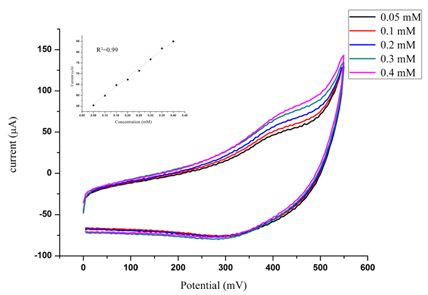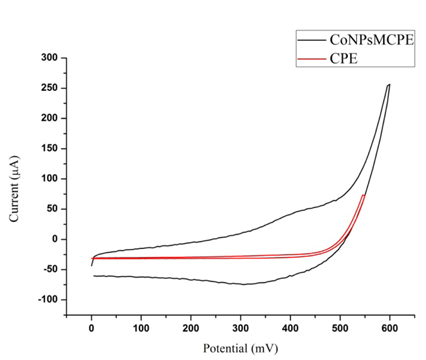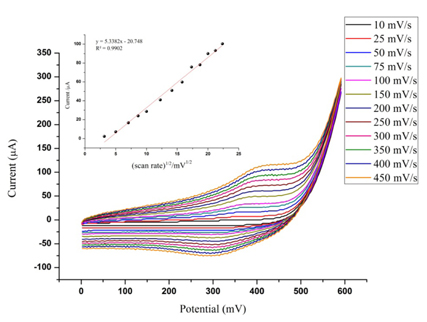Introduction
One of the great areas of electrochemical researches is chemically modified electrodes using as electrochemical sensors. There are two major methods for electrode modification; surface and bulk modification. Surface modification is an effective method including adsorption, covalent bonding, attachment of polymer films etc. [1-3]. One of the major parameters in producing modified electrodes is the nature of working electrode. Carbon paste electrode (CPE) due to ease of Preparation and capability to obtain a new reproducible surface is selected by researchers. Furthermore, having porous surface, low cost and low residual current are other advantages of CPE than other solid electrodes [4,5]. Recently the materials that are immobilized onto the electrode surface and their ability for fast electron transferring are under focused [6,7]. Transition metals with their good electrochemical capabilities as active materials are reported many times in literature [8-10]. Ni [3], Cu [11], Au [12], Ru [13] and Co are some transition metals that are reported for use in electrochemical sensors. Cobalt nano particle based materials which can flip-flop between various valence states under the effect of external electric fields in one hand and a potential reducing agent on the other hand are particularly interested in this regard. Various methods have been reported for synthesis of cobalt electrodes [14-16], but the synthesis of cobalt nanoparticles are very sensitive because many parameters effect on its physioelectrochemical properties [17]. Various methods such as chemical and physical synthetic procedures exist for production of nano particles that have limitations such as using toxic, expensive chemicals or devices. However, plant extract materials have been used for synthesis of nano particles which could be advantageous over chemical and physical methods. Cost effectiveness, simple sampling and environmental friendly are some advantages of green synthesis of nanoparticles [18-20]. Ascorbic acid is a powerful antioxidant naturally present in many foods, especially fruits and vegetables, and plays an important role in the prevention of infectious diseases. AA is frequently used in food industry as an antioxidant to prevent undesirable changes in color, taste and odor. It is of great interest to have a rapid and sensitive method for routine and reliable determination of AA. In the present study, the synthesis of Cobalt nano particles, and modification of carbon paste electrode using these nano particles for electro-oxidation of Ascorbic acid are presented. We modified the surface of CPE with Co/NPs and then studied the physioelectrochmical oxidation of AA in alkaline media.
Experimental
The cell and instruments
All electrochemical studies were carried out in a conventional three electrode cell powered by an EG&G model 273 potentiostat/galvanostat. The system is run by a PC through M270 interface. A dual Ag-AgCl saturated KCl and a Pt wire electrode were used as reference and counter electrodes, respectively. All studies were carried out at room temperature.
CoNPs preparation
CoNPs were synthesized using green method as described in [21]. 50 g of dried powdered fruits of Piper longum was added to 300 mL of 30% methanol solution in a 500 mL flask and well mixed. It was heated at 70Ōäā under vigorous stirring for 30 min and then was centrifuged and extracted.
In a typical synthesis of CoNPs, 15 mL of the extract of the plant fruits was added drop wise to 50 mL of 0.003 M aqueous solution of CoCl2 with constant stirring at 80Ōäā. Reduction of Co ions (CoII) to Co0 was completed after 30 min during which, changing the color of the reaction mixtures indicated the formation of Co nanoparticles. Then the colored solution of Co nanoparticles was centrifuged at 7000 rpm for 40 min to absolute precipitation of Co NPs.
Preparation of working electrode
Mixtures of CoNPs and graphite powder with ratio 5:95 were added to pure ethanol. Then the mixture heated and stirred by a magnet to evaporate the ethanol. Then it was mixed with mineral oil (75:25) and was blended by hand mixing with a mortar and pestle for preparation of carbon paste. The resulting paste was then inserted in the bottom of a glass tube with the area of 0.07 cm2. The electrical connection was implemented by a copper wire lead fitted into the glass tube. A fresh electrode surface was generated rapidly by extruding a small plug of the paste with a stainless-still rod and smoothing the resulting surface on white paper until a smooth shiny surface was observed. All the Materials in this work were of analytical grade, purchased form Sigma-Aldrich Co. and were used without any purification.
Results and Discussion
Fig. 1 presents cyclic voltammograms (CVs) of CPE and CoNPsMCPE in NaOH 0.1M at the scan rate of 100mV/s. As can be seen, in the absence of CoNPs there is no peak in CV of CPE, whereas by the addition of CoNPs a redox peak can be observed which is related to Co(III)/Co(IV). Because of the magnitude of nano particles' peak and the capacitive behavior of CPE, the redox peak related to Co(II)/Co(III) charge transfer may has been disappeared[7,22].
Fig. 2 presents CVs of modified electrode in NaOH 0.1M at various scan rates. As can be seen by increasing the sweep rate, the anodic peaks shifted to positive potentials whereas the cathodic ones to negative potentials.
For indicating the electrochemical activity of the surface redox couples, the plot of anodic and cathodic current peaks against potential sweep rate at low values was used. The surface coverage of redox species calculated as follows[23]:

where ╬ō* is the surface coverage of the redox species and ╬Į is the potential sweep rate taking average of both cathodic and anodic results. ╬ō* was calculated around 1.08├Ś109 mol cmŌłÆ2 which is almost equal to that of other reports [24].
Fig. 3 presents the CVs of CoNPsMCPE in the presence of various concentrations of AA in 0.1M NaOH at the scan rate of 50 mV/s. As can be seen, by increasing the concentration of AA the current of anodic sweep enhances. This results show that the modified electrode has good activity for oxidation of AA in alkaline media. Fig. 3. (inset) shows the calibration curve for AA concentration. As can be seen, the modified electrode has a linear response to AA concentration.
Fig.┬Ā3.
CVs of CoNPsMCPE in the presence the various concentrations of AA in 0.1M NaOH at the scan rate of 50 mV/s.

In order to investigate the electrocatalytic activity of CoNPsMCPE, CVs of the electrode at 0.1M NaOH solution containing 0.4 mM AA were recorded (Fig. 4). The pattern shows that AA electrooxidation has fast kinetic properties in which, by increasing the sweep rate the anodic peak of AA oxidation and Co peak do not separate. Fig. 4 (inset) is the diagram of Ip versus the square root of scan rate. The diagram shows that the electrooxidation of AA occurres under mass transfer controlled process. To study some physioelectrochemical properties of the modified electrode, double potential step chronoamperometry was used. Fig. 5 shows the double step chronoamperograms of the modified electrode at various concentrations of AA. The first potential step is pointed at 440 mV that was derived from oxidation potential of AA and the second step pointed at 100 mV that is far from the potential of AA oxidation. At first step, by increasing the concentration of AA the current enhanced, but all diagrams at second step are the same implying that AA electrooxidation on the surface of CoNPsMCPE is irreversible. In addition, chronoamperometry was used to evaluate chemical reaction rate between AA and modified layer (k) according to:
Fig.┬Ā5.
Double step potential chronoampermograms of CoNPsMCPE in 0.1M NaOH at various concentrations of AA. The first step pointed at 440 mV and the second one at 100 mV.


where IC and IL are currents in the presence and absence of AA respectively, ╬│ = kct is the argument of the error function, k is the catalytic rate constant, C is bulk concentration of AA and t is the elapsed time. In the cases where ├Ż>1.5, erf (├Ż1/2) is almost equal to unity and the above equation can be reduced to [25]:

From the slope of the IC/IL versus t1/2 plot, presented in Fig. 6 (left), the mean value of k for the concentration range of 0.1 to 0.5 M of AA was obtained as 1.4├Ś106 cm3molŌłÆ1sŌłÆ1. Furthermore with this method we can obtain the diffusion coefficient according to:
Fig.┬Ā6.
Dependence of IC/IL on t1/2 (right) and current on t1/2 (left) both derived from the chronoamperogams of Fig. 5.

Conclusion
In this work the electrooxidation of AA on the surface of CoNPsMCPE in alkaline media was studied. The results showed that CoNPsMCPE has good AA oxidation activity in alkaline media and can be a suitable candidate as an AA sensor. The results show that AA electrooxidation on the surface of CoNPsMCPE is irreversible and kinetic properties of the modified electrode are comparable with other cobalt electrodes.











